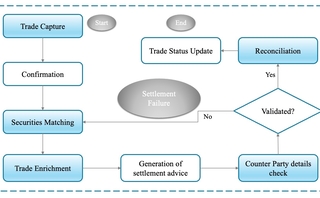Terminal velocity: MarketAxess bets on algo trading as electronification of fixed income gathers speed
MarketAxess hopes to bring fresh ideas from other asset classes with acquisition of multi-asset algorithm provider Pragma.

When it comes to markets, the celebrated economist John Maynard Keynes believed that “the difficulty lies not in the new ideas, but in escaping from old ones.”
Keynes’ struggle to shrug off habitual modes of thought feels particularly prescient today, as the rapid modernization of traditionally analog markets has paradoxically prompted industry leaders to import familiar ideas wholesale from more developed asset classes.
Yet, for the players who first identify the gold standard in other markets and bring it across into their own asset classes, the reward could be a competitive edge in a fast-growing market.
This was a key consideration for MarketAxess when, on August 7, it announced its acquisition of Pragma, a multi-asset algorithmic trading technology provider. In the 20 years since it was founded, Pragma has made algorithms for the increasingly digital worlds of equities and foreign exchange (FX). As electronic trading of fixed income gathers pace, MarketAxess believes that the proliferation of data that comes with higher velocity markets will give algorithms a central role here, too.
Gareth Coltman, global head of automation at MarketAxess, tells WatersTechnology that the deal was prompted by the increasing sophistication of both clients and markets. “There was much more interaction from every side on an automated basis, deployment of algos by dealers, opportunities to interact with other kinds of liquidity in the market. We felt like the best response was to partner with Pragma, which has been through that kind of market structure evolution before,” Coltman says.
Innovation was a key theme in MarketAxess’ recent second-quarter earnings call. As low volatility squeezes trading volumes, the major fixed-income venues are turning to new data products and automation tools to drive more traffic to their platforms and grow market share. The same hunt for growth also fueled a string of high-profile tech acquisitions seen earlier this year by Bloomberg, Numerix, and Trading Technologies.
With automation protocols accounting for nearly 10% of trading volume on MarketAxess, CEO Chris Concannon stressed the importance of growing this offering to shareholders in a recent earnings call. In particular, he touted the pilot of Adaptive Auto-X, MarketAxess’ first client algorithm for US credit markets, which also uses smart order routing to direct orders to MarketAxess’ various liquidity pools.
“What we plan to do with Pragma is to build on what we’ve already started with Adaptive Auto-X, which is to develop more sophisticated, higher velocity automation tools to our platform,” Coltman explains.
MarketAxess’ largest and most advanced clients likely already use algorithms in their fixed-income operations. But for smaller or less sophisticated asset managers, dealers, and banks, the ability to quickly design an algorithm to match their needs “could be helpful or even key to attracting new customers and keeping the existing customers engaged on the platform,” according to an executive at a vendor with experience in algorithmic fixed-income trading.
“Many of these players execute most of their trades on one or two platforms, and having an algo could prompt some to direct a larger portion of their volume through a single platform,” they add.
The algo race
The terms “fixed income” and “algo trading” may seem unlikely bedfellows. Traditionally, it is in the more electronic markets like equities that trading desks normally entrust a significant portion of their work to algorithmic methodologies. But MarketAxess is not the only company investing in this area.
On a recent earnings call, Billy Hult, CEO of rival fixed-income trading venue Tradeweb, said that “the future of the marketplace is going to be more algorithmic trading, not less,” when an analyst asked him whether he viewed burgeoning interest in buy-side execution management systems as a competitive threat. Hult said on the call that he thought the emerging trend could prove an advantage for Tradeweb, given its history of working with EMS functionality.
Market-makers have also been vocal about their engagement in automated fixed-income trading strategies lately. Most notably, high-frequency market-maker Citadel Securities announced its intention to move into the US corporate bond market.
Systematic liquidity providers have historically been more tight-lipped about their strategies, but news of innovations in algorithmic trading at large sell-side institutions occasionally makes headlines.
“Algo trading is on the rise in FI, although we are still in the early innings,” says Audrey Blater, senior analyst at research firm Coalition Greenwich. “There is a general desire for more automation and using trader expertise for the more difficult trades,” she adds.
In a recent whitepaper, ETF market-maker Flow Traders found that algorithms were responsible for 20% of executed volumes in fixed income in 2022, a figure which has been growing steadily since 2010. But that figure pales in comparison with the proportions of trading volume executed by algorithms in FX and equities markets the same year, which were just over 40% and 70%, respectively.
Equities and FX also comprised most of the over $2 trillion in algorithmic order flow handled by Pragma in 2022. But the company’s CEO, David Mechner, says that the experience that Pragma has gained in other markets is applicable to fixed income, too.
“There are exchange-like structures, there are liquidity providers, bilateral liquidity providers, streaming or RFQ. So the palette of ways of interacting with liquidity is there, and it’s just a matter of taking those tools and our know-how,” Mechner tells WatersTechnology. “Basically, as markets become electronic, generally what happens is that the velocity of the data increases and the volume of the data increases, and there’s a set of techniques that we see repeated across markets as markets evolve. … And so we expect to recapitulate a lot of that going forward in fixed income.”
In 2020, Pragma unveiled a set of execution algorithms that used deep learning to decide the routing, pricing, and timing of orders.
“The know-how and technologies that we developed over the course of that project, which was focused on equities, has a lot of application to other asset classes. We think we’re going to be leveraging those same capabilities when we address some of the data problems and execution problems in fixed income,” says Pragma’s Mechner.
Sources have told WatersTechnology that an algorithm provider linked to a single venue would not be helpful for larger accounts that trade on multiple venues. The Pragma acquisition could still leave room in the market for other venue-agnostic algorithm providers.
But the executive at a vendor with experience in algorithmic fixed-income trading suggests that “the more likely scenario is that an EMS could develop or acquire such capabilities and would have greater success than a standalone algo provider.”
Breaking the asset class barrier
Although algorithms are Pragma’s bread and butter, another significant part of its business is workflow software. In 2022, the company announced a deal which would see the New York Stock Exchange’s floor brokers provided with Pragma’s Polaris Execution Management System. Mechner says that the acquisition should not affect those plans, and that Pragma will continue leveraging its software business for MarketAxess’ priorities.
Given that Pragma specializes in FX, another potential use could be to facilitate currency risk hedging for bond buyers. MarketAxess’ Concannon touched on this in the press release announcing the acquisition, saying that “Pragma’s years of expertise with FX algos provides a unique opportunity for FX hedging solutions for our emerging market clients.”
With voice trading still dominant in emerging markets bonds, the executive at the vendor believes that this segment is a potential growth opportunity. “This is an excellent way for MarketAxess to enter a different asset class, providing a new service to its core audience. FX hedging can be highly complementary to MarketAxess’ non-USD bond business, especially in local markets, where FX risk has such a significant impact,” he said.
Jesse Forster, head of equity market structure and technology at Coalition Greenwich, says that the knowledge and contacts that Pragma has built up in FX and equities will be valuable to MarketAxess in FI as the market evolves.
“Fixed income now may look like equities 25 years ago in terms of electronification, but it’s advancing rapidly. Asset class doesn’t really matter—both the buy and sell side consistently cite ease of use, reliability and high quality support as the most important attributes of trading technology. Leveraging organizations like Pragma that have deep experience in the electronic evolution in equities, will be vital,” Forster says.
Ultimately, it is Pragma’s combination of automation technology and a quant and data skillset that made it so attractive to MarketAxess, Coltman says. And while he recognizes that the worlds of FX and equities are far removed from MarketAxess’ home field, he also stresses that the fundamental trends in those markets are similar to what is currently going on in fixed income. To him, the emergence of sell-side algos and sell-side market-making indicate increasing participation in the markets in a systemic way. Coltman believes that this, as well as a gradual trend towards smaller ticket sizes and faster trading, mirrors the direction of equities and FX markets in previous years.
“Thinking about it from that first principles basis, it’s only a logical endpoint to say, ‘What can we learn from those other markets that might help us predict where fixed income will be in X years’ time?’”
Additional reporting by Rebecca Natale
Further reading
Only users who have a paid subscription or are part of a corporate subscription are able to print or copy content.
To access these options, along with all other subscription benefits, please contact info@waterstechnology.com or view our subscription options here: http://subscriptions.waterstechnology.com/subscribe
You are currently unable to print this content. Please contact info@waterstechnology.com to find out more.
You are currently unable to copy this content. Please contact info@waterstechnology.com to find out more.
Copyright Infopro Digital Limited. All rights reserved.
You may share this content using our article tools. Printing this content is for the sole use of the Authorised User (named subscriber), as outlined in our terms and conditions - https://www.infopro-insight.com/terms-conditions/insight-subscriptions/
If you would like to purchase additional rights please email info@waterstechnology.com
Copyright Infopro Digital Limited. All rights reserved.
You may share this content using our article tools. Copying this content is for the sole use of the Authorised User (named subscriber), as outlined in our terms and conditions - https://www.infopro-insight.com/terms-conditions/insight-subscriptions/
If you would like to purchase additional rights please email info@waterstechnology.com
More on Trading Tech
For MarketAxess, portfolio trading buoys flat revenue in Q3
The vendor is betting on new platforms like X-Pro and Adaptive Auto-X, which helped forge a record quarter for platform usage.
Quants look to language models to predict market impact
Oxford-Man Institute says LLM-type engine that ‘reads’ order-book messages could help improve execution
JP Morgan pulls plug on deep learning model for FX algos
The bank has turned to less complex models that are easier to explain to clients.
Nasdaq says SaaS business now makes up 37% of revenues
The exchange operator’s Q3 earnings bring the Adenza and Verafin acquisitions center stage.
Harnessing generative AI to address security settlement challenges
A new paper from IBM researchers explores settlement challenges and looks at how generative AI can, among other things, identify the underlying cause of an issue and rectify the errors.
The causal AI wave could be the next to hit
As LLMs and generative AI grab headlines, another AI subset is gaining ground—and it might solve what generative AI can’t.
Waters Wrap: Operational efficiency and managed services—a stronger connection
As cloud, AI, open-source, APIs and other technologies evolve, Anthony says the choice to buy or build is rapidly evolving for chief operating officers, too.
BlackRock forecasts return to fixed income amid efforts to electronify market
The world's largest asset manager expects bond markets to make headway once rates settle.








